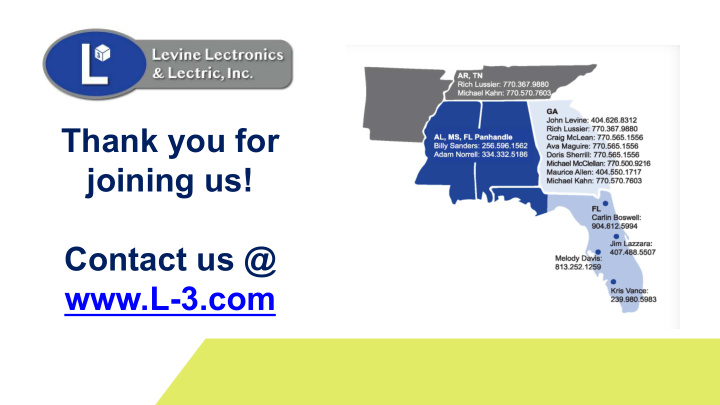



Thank you for joining us! Contact us @ www.L-3.com
REMOVING PERSONNEL From Arc Flash Hazards
Overview Discussion the basis for remote racking as an arc flash mitigation strategy. - inoLECT Intro - Incident Energy (Arc Flash) & Risk Assessment (70E) - Incident Energy Mitigation - Mitigation Technique: Universal Remote Racking - Applications - Recommended Specifications - Q&A - Submit via chat!
inoLECT Our mission is to help our clients improve electrical safety and reliability.
UNIVERSAL REMOTE RACKING - EVOLUTION
Incident Energy (Arc Flash) – Definition & Causes NFPA 70E defines 'Arc Flash' as a dangerous condition associates with the possible release of energy caused by an electric arc. • Equipment failure due to lack of maintenance, use of substandard repair parts, improper installation, or even normal wear and tear • Dropping a tool or conductive object across conductors • Breaks or gaps in insulation • Dust, corrosion or other impurities on or between the surface of conductors • Human Error
Hazards • Electric Arcing Temps. (35,000⁰F) - Rapid Expansion of Air & Intense Light • Molten Metal – Copper Vapor Expands 67,000 Times & Creates Inhalation Hazard • Mechanical Hazards – Shrapnel, Sound & Pressure Waves Cause Loss of Hearing & Concussive Forces Key Energy Levels: 1.2 Cal/Cm 2 - 2 nd Degree Burn • || 10.7 Cal/cm 2 - 3 rd Degree Burn || 4-5 Cal/Cm 2 – Ignition of Non-FR Clothing
Statistics • 80% of electrical-related accidents and fatalities involving “qualified workers” are caused by arc flash or arc blast. Between 2007 & 2011, more than 2,880 fines were assessed for not meeting OSHA regulations 1910.132(d), which averages out to 1.5 fines a day. - OSHA.Gov • 5 to 10 Arc Flash Incidents occur in electrical equipment every day in the US. At least 1 results in a fatality. - CapSchell, Inc. 2007 • 2,000 electrical workers are treated in specialized burn trauma centers each year as a result of arc flash injuries.” – EFSI (Electrical Safety Foundation International) • Due to the violent nature of arc flash exposure injuries, some are fatal. For those that are non-fatal, it’s common for the employee to never regain their past qualify of life . Extended medical care is often needed and very costly. The average cost of treatment is upward of $1.5 million. Total cost to the employer can be $8 to 10 million in litigation fees. – WSAC (Workplace Safety Awareness Council)
Risk Assessment NFPA 70E 2018 has an increased emphasis on risk assessment. • Identify Hazards • Estimate Likelihood of Occurrence • Estimate Potential Severity of Injury • Determine if Protective Measures are Require. Consensus = Insertion/Removal of Power Circuit Breakers is High Risk!
Addressing Electrical Hazards - Physically Remove the Hazard - Replace the Hazard - Isolate People From the Hazard - Change the Way People Work - Protect the Worker with PPE
Incident Energy Mitigation • Reduce Fault Current – Increase Transformer Impedance – Current Limiting Reactors • Increase the Working Distance – Incident energy decreases exponentially with increased working distances. – Remote Racking & Operation Of Switchgear – Many tasks may not be able to be accomplished remotely. – Remote racking devices may not operate as desired. • Reduce the Fault Clearing Time – Incident energy is directly proportional to the fault clearing time. – Many protection schemes & technologies are available.
Sample Remediation Analysis
POLL
Mitigation Technique Example – Universal Remote Racking (Increase Distance to Hazard) BEFORE AFTER
EATON VCP-W – MV Vacuum Breaker No Modifications! Door Open or Closed Operation Single or Two-High Operation Passive Racking Interlock via Spring Loaded Plate
GE AM ‘MAGNEBLAST’ – VERTICAL LIFT No Modifications! Monitoring Limit Switches No Longer Required Prevents Damage from OEM DC Motor Over-Travel Scenario
ALLIS-CHALMERS MA/FC MECHANICAL RETROFIT SOLUTION BEFORE AFTER (Ratcheting Motion w/ Lever) Rotational w/ Door Closed
ABB/ITE HK – INTERLOCK TYPES & EXTENSIONS OFFSET MISSING EXTENSION NON- OFFSET
INTERLOCK ACUATORS - ABB ADVAC Actuator driven solutions exist to allow racking without Operator intervention.
POLL
Recommended Specifications • Universal – 480V to 38kV Drawout Style Breakers (ANSI, NEMA & IEC) • No Switchgear Modifications • PLC Controlled - Intelligent Operation & Monitoring • “Racking Complete” - Turns, Torque AND/OR Both! • Breaker Position Monitoring • Torque Management – Multiple Torque Parameters • Speed Controlled Motor – Lessens Torque at Conn./Disc. • Spring Loaded Horizontal Motor – Applies Forward Pressure • Interlock Actuator Devices (For Certain Types) • Torque Monitoring - Graphical Feedback • Remote w/ Distance > IE Hazard Boundary • Remote TRIP/CLOSE via Breaker Pushbuttons • Commissioning & Training – Manufacture’s specialist should provide initial onsite support to setting parameters based on field conditions of your breakers.
Key Feedback – Torque Graphing (ITE HK – Rack Out, Rack In Sequence) LEGEND: Torque, Revolutions & Motor Speed .
Key Feedback – Torque (Example: No Stabs In Cell) LEGEND: Torque, Revolutions & Motor Speed .
Final Thoughts + Q&A Incident Energy (Arc Flash) levels can be addressed by several modern Technologies & Engineering Practices Including Remote Racking: • Elimination Strategy– Remote Racking & Operation • PPE should be the last option. • Site Survey of Breaker (Photos) & Key Specifications Risk can be significant at low Incident Energy levels due to fault current. This is not obvious!
고맙습니다 고맙습니다 감사합니다 225-751-7535 info@inolect.com
Recommend
More recommend